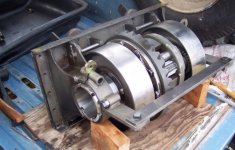Greetings- Just found the forum a few days ago and have really enjoyed poking through the archives. There's a pile of good info here. Several other piles too.  Very helpful, entertaining and encouraging as I wallow deeper and deeper into grease and grime. I keep thinking there's not much further I can go, but there always seems to be more.
Very helpful, entertaining and encouraging as I wallow deeper and deeper into grease and grime. I keep thinking there's not much further I can go, but there always seems to be more.
I'm looking at replacing the crown and pinion set, so I'll have the differential all apart, and there is a fair amount of play in the brake drum bushings; the edges of the drums will move about 1/16" when twisted side to side. Is there a standard method to measure the play (feeler gauge slid in the bushing?) and an allowable tolerance, or is it more a case of "that doesn't look like quite $40 worth of new bushing yet". Not having seen how tight new bushings are, I haven't a clue. I do know my wallet is tighter than the bushings, but I intend to work this machine in the woods for a while and I don't want to have to pull it all apart again in six months.
On a related note, has anyone found the large pinion gear bearing seat in a differential carrier to be out of round? I've seated (and reseated) a new race in it and the new bearing doesn't ride right. The rolls don't roll all the way around, just on opposite sides. I thought the race might be skewed, but it is fully seated and the individual rollers skip rolling in the same areas both times I set the race. There was very bad asymmetric race wear on the bearings I removed, and I suspect this might be the root cause of that.
Thanks
 Very helpful, entertaining and encouraging as I wallow deeper and deeper into grease and grime. I keep thinking there's not much further I can go, but there always seems to be more.
Very helpful, entertaining and encouraging as I wallow deeper and deeper into grease and grime. I keep thinking there's not much further I can go, but there always seems to be more.I'm looking at replacing the crown and pinion set, so I'll have the differential all apart, and there is a fair amount of play in the brake drum bushings; the edges of the drums will move about 1/16" when twisted side to side. Is there a standard method to measure the play (feeler gauge slid in the bushing?) and an allowable tolerance, or is it more a case of "that doesn't look like quite $40 worth of new bushing yet". Not having seen how tight new bushings are, I haven't a clue. I do know my wallet is tighter than the bushings, but I intend to work this machine in the woods for a while and I don't want to have to pull it all apart again in six months.
On a related note, has anyone found the large pinion gear bearing seat in a differential carrier to be out of round? I've seated (and reseated) a new race in it and the new bearing doesn't ride right. The rolls don't roll all the way around, just on opposite sides. I thought the race might be skewed, but it is fully seated and the individual rollers skip rolling in the same areas both times I set the race. There was very bad asymmetric race wear on the bearings I removed, and I suspect this might be the root cause of that.
Thanks

 - I might also try blueing the seat and fitting a series of turned plugs into it to scrape the blue off the high spots and then ease them down by hand. Maybe I can get it round enough and locktite the race in. I really don't want to reinstall a diff carrier 'cause it sounds like a tough job to get the drive axles lined up right- is it difficult to do that? The service manual says to use a set of rods and sleeves, which I don't have.
- I might also try blueing the seat and fitting a series of turned plugs into it to scrape the blue off the high spots and then ease them down by hand. Maybe I can get it round enough and locktite the race in. I really don't want to reinstall a diff carrier 'cause it sounds like a tough job to get the drive axles lined up right- is it difficult to do that? The service manual says to use a set of rods and sleeves, which I don't have.







 The next one certainly will be easier.
The next one certainly will be easier.